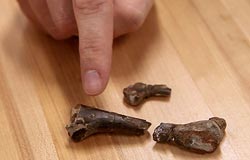 |
| South Dakota School of Mines & Technology Clint Boyd, Ph.D., of the South Dakota School of Mines & Technology, points to a crocodyliform tooth embedded in the femur of a young dinosaur. |
First fossil evidence shows small crocs fed on baby dinosaurs RAPID CITY, S.D. (Feb. 27, 2013) – A South Dakota School of Mines & Technology assistant professor and his team have discovered a new species of herbivorous dinosaur and today published the first fossil evidence of prehistoric crocodyliforms feeding on small dinosaurs. Research by Clint Boyd, Ph.D., provides the first definitive evidence that plant-eating baby ornithopod dinosaurs were a food of choice for the crocodyliform, a now extinct relative of the crocodile family.
While conducting their research, the team also discovered that this dinosaur prey was a previously unrecognized species of a small ornithopod dinosaur, which has yet to be named. The evidence found in what is now known as the Grand Staircase Escalante-National Monument in southern Utah dates back to the late Cretaceous period, toward the end of the age of dinosaurs, and was published today in the academic journal PLOS ONE (Public Library of Science ONE). The complete research findings of Boyd and Stephanie K. Drumheller, of the University of Iowa and the University of Tennessee, and Terry A. Gates, of North Carolina State University and the Natural History Museum of Utah, can be accessed at http://dx.plos.org/10.1371/journal.pone.0057605. A large number of mostly tiny bits of dinosaur bones were recovered in groups at four locations within the Utah park – which paleontologists and geologists know as the Upper Cretaceous (Campanian) Kaiparowits Formation – leading paleontologists to believe that crocodyliforms had fed on baby dinosaurs 1-2 meters in total length. Evidence shows bite marks on bone joints, as well as breakthrough proof of a crocodyliform tooth still embedded in a dinosaur femur.
The findings are significant because historically dinosaurs have been depicted as the dominant species. “The traditional ideas you see in popular literature are that when little baby dinosaurs are either coming out of a nesting grounds or out somewhere on their own, they are normally having to worry about the theropod dinosaurs, the things like raptors or, on bigger scales, the T. rex. So this kind of adds a new dimension,” Boyd said. “You had your dominant riverine carnivores, the crocodyliforms, attacking these herbivores as well, so they kind of had it coming from all sides." Based on teeth marks left on bones and the large amounts of fragments left behind, it is believed the crocodyliforms were also diminutive in size, perhaps no more than 2 meters long. A larger species of crocodyliform would have been more likely to gulp down its prey without leaving behind traces of “busted up” bone fragments. Until now, paleontologists had direct evidence only of “very large crocodyliforms” interacting with “very large dinosaurs.” “It’s not often that you get events from the fossil record that are action-related,” Boyd explained. “While you generally assume there was probably a lot more interaction going on, we didn’t have any of that preserved in the fossil record yet. This is the first time that we have definitive evidence that you had this kind of partitioning, of your smaller crocodyliforms attacking the smaller herbivorous dinosaurs,” he said, adding that this is only the second published instance of a crocodyliform tooth embedded in any prey animal in the fossil record. “A lot of times you find material in close association or you can find some feeding marks or traces on the outside of the bone and you can hypothesize that maybe it was a certain animal doing this, but this was only the second time we have really good definitive evidence of a crocodyliform feeding on a prey animal and in this case an ornithischian dinosaur,” Boyd said.
The high concentrations of tiny dinosaur bones led researchers to conclude a type of selection occurred, that crocodyliforms were preferentially feeding on these miniature dinosaurs. “Maybe it was closer to a nesting ground where baby dinosaurs would have been more abundant, and so the smaller crocodyliforms were hanging out there getting a lunch,” Boyd added. “When we started looking at all the other bones, we starting finding marks that are known to be diagnostic for crocodyliform feeding traces, so all that evidence coming together suddenly started to make sense as to why we were not finding good complete specimens of these little ornithischian dinosaurs,” Boyd explained. “Most of the bites marks are concentrated around the joints, which is where the crocodyliform would tend to bite, and then, when they do their pulling or the death roll that they tend to do, the ends of the bones tend to snap off more often than not in those actions. That’s why we were finding these fragmentary bones.” In the process of their research, the team discovered through diagnostic cranial material that these baby prey are a new, as yet-to-be-named dinosaur species. Details on this new species will soon be published in another paper.
MEDIA CONTACT Fran LeFort Media relations manager (605) 394-6082 Fran.LeFort@sdsmt.edu
No comments:
Post a Comment